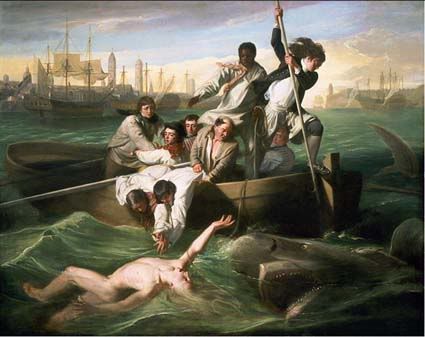Watson and the Shark, John Singleton Copley, 1778.
This is one of my favorite works of early American art. It depicts the rescue of Brook Watson, a 14yr old cabin boy, from a shark attack in Havana, Cuba. Copley had heard of the attack and was always up for whipping out a melodramatic canvas - see his Seige and Relief of Gibralter and Death of Major Peirson. Watson was eventually rescued, by the way, though he lost part of a leg to the shark. The original of the painting hangs in the National Gallery of Art in Washington D.C. where I visit it often. If you take a closer look, I think you'll appreciate why.
First of all, it's clear that Copley had never actually seen a shark, because this one looks like no shark found in nature. Look at that oddly flattened jaw (was he maybe going for lips?), those stubby teeth, that rounded side fin, and - my favorite part - those big nostrils! (Why would a fish need nostrils?)
Next I draw your attention to the unfortunate Watson, who is not only about to get eaten but whose clothes have mysteriously disappeared. Did the shark eat his clothes first? Or were they dissolved by the water? What exactly was going on in that boat before Watson fell overboard?
Finally, there's the whole anachronism of what appears to be a 20' shark swimming about the Port of Havana, and that handy harpoon, because apparently they also get a lot of whales there too.
At his death, Watson bequeathed the painting to Christ's Hospital, with the hope that it would prove "a most usefull Lesson to Youth". So children: listen up! Do not go skinny dipping in the Port of Cuba! I bet that's saved a lot of lives over the years.
Full disclosure: I feel bad ragging on my man Copley. His portraits are absolutely brilliant - if you don't believe me, just google his name and see what you get. But, really, this painting isn't worthy of him. See what happens when you send an otherwise sensible born American portrait painter off to Italy and fill his head with fancy notions like classicalism and romantacism?

No comments:
Post a Comment